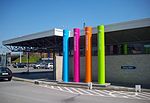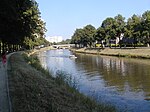Sint-Amandsberg
East Flanders geography stubsPopulated places in East FlandersSub-municipalities of Ghent

Sint-Amandsberg is a sub-municipality of Ghent, Belgium. The municipality was formed in 1872 after splitting from Oostakker. It is served by the Bus and train station of Gent Dampoort on the Ghent Antwerp NMBS/SNCB line. During the First World War, on 7 June 1915, the German airschip LZ37 crashed after being destroyed by Reginald Warneford. A street was named Reginald Warnefordstraat on the spot where the airship crashed.
Excerpt from the Wikipedia article Sint-Amandsberg (License: CC BY-SA 3.0, Authors, Images).Sint-Amandsberg
Heilig-Hartplein, Ghent
Geographical coordinates (GPS) Address Nearby Places Show on map
Geographical coordinates (GPS)
| Latitude | Longitude |
|---|---|
| N 51.053888888889 ° | E 3.7491666666667 ° |
Address
Heilig Hartkerk (Heilig Hart)
Heilig-Hartplein
9040 Ghent
East Flanders, Belgium
Open on Google Maps








